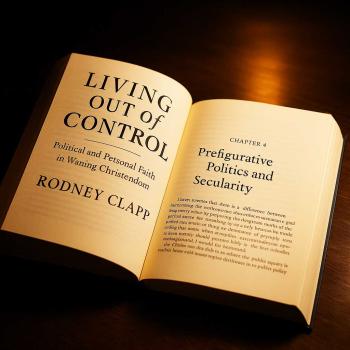The following guest blog post is by Tyler Phillips and is used here with his specific granted permission. I will not expect him to respond to comments and questions. (Do not address questions to him.) The purpose of posting his essay here is to provoke thought and dialogue. In my (Roger Olson’s) opinion, Mr. Phillips’s views and recommendations are much needed—to be heard and heeded by Americans and especially by American Christians (because it is based on Christian principles). Far too many American Christians seem not to care about restorative justice and seem to support mass incarceration of convicts without concern for rehabilitation and restoration to a productive place in society. Only constructive comments will be posted in response to this essay/blog post. They may be critical, but they must also be constructive—contributing to reflection, thought, and action. Mere reactions, diatribes, hostile questions not aimed at promoting serious consideration of the issues addressed and the solutions suggested will be deleted.
The Criminal Justice System and Restorative Justice
Tyler Phillips (Used by Permission)
The need for reform within America’s criminal justice system is undeniable. The questions presently facing the justice system are numerous, including prison overpopulation and the morality of capital punishment. Far worse, the justice system has failed to adequately redress its complicity in structural racism. Many have written about the oppression of minority groups via racially-based mass incarceration. Further, repeated instances of homicidal police brutality against unarmed black men followed by the acquittal of the responsible officer by a majority-white jury represent major failures of justice. These challenges are bound up with the corrosion of trust and peace in local communities. With mass incarceration comes absent fathers and cyclical poverty. With inadequate justice for the victims of police brutality comes distrust and resentment between minority citizens and officers. It is impossible to identify a single solution for problems as pervasive as these. Still, the Christian calling to anticipate the justice of God’s eschatological reign through deeds and witness demands that Christians seek alternatives to address the present crisis. One promising and increasingly implemented model for change is “restorative justice.” In what follows, I will defend the Christian practice of restorative justice for both its compatibility with biblical models of justice and its practical results. I will conclude by considering how restorative justice should inform both ecclesial and public ethics.
First, it is necessary to outline the essential principles and practices of restorative justice. Restorative justice is an alternative to penal or retributive justice. In the framework of retributive justice, a crime is understood as an offense against society that requires a proportional punishment. This punishment is meant to ‘pay the debt’ of the offense and discourage future offenses. Typically, though not always, this ‘debt’ is owed primarily to the state and its payment is considered a sufficient remedy. Restorative justice, which was pioneered in its contemporary expression by Mennonite communities (Thomas Noakes-Duncan, “The Emergence of Restorative Justice in Ecclesial Practice,” Journal of Moral Theology 5.2, 2016, 3), offers a more holistic account of the nature of crime and its solution. Without rejecting the role of punishment, advocates for restorative justice contend that a crime is better understood as a harm against an individual and a “disruption of peace” within an actual community (Lorraine Stutzman Amstutz, “Restorative Justice: The Promise and the Challenges,” Vision 14.2, 2013, 25). It is more than an abstract transgression against the state’s laws. The problem of the crime, then, is not dealt with until the harm is ameliorated, and the peace of the community is restored for both victim and offender. While punishment may play some role in this process, the ultimate goal is always reconciliation, and punishment is only sought insofar as it serves this end. Therefore, as Amstutz summarizes, “a just response to harm or wrongdoing must (1) work as much as possible to repair the harm; (2) encourage taking appropriate responsibility for addressing needs… and (3) involve those affected by harm or wrongdoing… in the resolution” (Amstutz 26). In practice, this is carried out by dialogue sessions between the victim, the offender, official mediators, and the wider community which follow a process of deliberation to arrive at a solution adequate to the harm experienced by the victim and acceptable to everyone who holds a stake in the situation. The community is enabled to partake in the solution.
The primary strength of restorative justice for Christian ethics is found in its agreement with the purpose and practice of justice in Scripture. First, the purpose of Biblical justice is restoration. In the biblical narrative, God’s justice is not simply punitive, even as it contains punitive aspects. Rather, Scripture presents its readers with a vision of justice that is primarily concerned with an eschatological hope for rectification and reconciliation (Duncan B. Forrester, “Social Justice and Welfare” in The Cambridge Companion to Christian Ethics, Cambridge: Cambridge, 2001, 198). Humanity has erred, and the world has been taken captive to sin and death, but God has acted in Christ to set the world to rights. The future towards which all of creation strains is one in which God will dwell with his people and “wipe every tear from their eyes,” righting every wrong (Revelation 21:3-4). As N. T. Wright puts it, “God’s justice is not simply a blind dispensing of rewards for the virtuous and punishments for the wicked… [but] a saving, healing, restorative justice because the God to whom justice belongs is the Creator God who has yet to complete his original plan (N. T. Wright, Evil and the Justice of God, Downer’s Grove: InterVarsity, 2006, 64). Thus, in the perspective of the biblical narrative, all punishment is an instrumental, second-order priority rather than a final goal. Hans Boersma concludes that “Punishment is eminently understandable if the very fabric of justice is at stake and if the punishment serves to advance this justice” (Hans Boersma, “Eschatological Justice and the Cross,” Theology Today, 60, 2003, 194). Punishment may be necessary to justice, but it should not be confused with justice itself. Mere punishment via a Lake of Fire would not be biblical justice without a New Heavens and Earth.
Further, the purpose of biblical justice is not merely to preserve the present, fallen order but to advance deliverance for the poor and oppressed. The world has been ravaged by sinful abuses of power, and part of God’s setting the world to rights must include rectifying this situation by delivering the marginalized. As Stassen and Gushee put it, “the normative picture of justice is the exodus of the oppressed from bondage to community” (Glen H. Stassen and David P. Gushee, Kingdom Ethics, Downer’s Grove: InterVarsity, 2003, 212). They go on to outline the narrative arc of God’s delivering acts in four steps. God’s justice delivers the powerless from injustice, challenges the power of the oppressor, ends cycles of violence, and gathers outcasts into restored community (Stassen and Gushee, 349-357.) Any Christian project of justice cannot end its course with a mere punishment of offenders; it must have its ultimate goal to be the restoration of all members involved to active and thriving participation in community, seeking to rectify unjust social structures which contribute to crime rather than simply reacting to crimes already committed.
Growing out of this understanding that the ultimate purpose of justice is restoration, Scripture also demonstrates that human practice of justice should have a restorative orientation as well. This principle is significant to the people of God in both the Old and New Testament. In the Old Testament, Israel was called to be (even if it failed to) an embodied witness to God’s reign on earth. As Amstutz puts it, Israel was “to function in a state of shalom, a social peace understood as more than the absence of conflict and instead as encompassing right relationships” (Amstutz 27). Accordingly, any sin or transgression in the community threatened and harmed the peace of the community and required reparation. The Old Testament law was thus oriented to community restoration. Noakes-Duncan cements this connection, noting that “the Hebrew word for restitution (shillem) derives from the same root as shalom, indicating that restitution also has the concrete meaning of ‘making peace’” (Noakes-Duncan 32). Even Old Testament sacrifices, which addressed grievances directly unto God, were ultimately concerned with making peace between God and the offender for the sake of Israel, rather than simply for the sake of punishment.
This same principle of restoring peace is found in the New Testament ethics of Jesus. First, the reign of God inaugurated by Jesus is understood to be the fulfillment of the Old Testament expectations for the deliverance of the poor and oppressed into God’s future shalom (Stassen and Gushee 357). Second, the cruciform example of Jesus demonstrates that, while costly, the goal of all justice is reconciliation, even for sinners. Finally, disciples of Jesus are called to anticipate the reign of God that has dawned in Jesus’ ministry by putting into practice his teaching and concern for restoration of all things (Matthew 7:21-23). Restoration and reconciliation, not punitive justice for its own sake, must be the ultimate concern of a church which proclaims the reign of God.
If it is granted that biblical justice is restorative in practice and intent, two questions remain. First, is contemporary “restorative justice” actually successful at accomplishing restoration? If it is not, then it seems to fall short of the biblical imperative. Second, how should the church live out this vision in its own life and in its relationship to the state?
First, there is ample empirical evidence that restorative justice is successful in its goals for restoring victim, offender, and community compared to other models of justice. John Braithwaite’s book Restorative Justice and Responsive Regulation provides a convincing summary of a wide collection of evidence. Regarding victims, Braithwaite concludes that, in a wide variety of restorative programs, victims report higher rates of satisfaction with the results of justice processes, including reduced fear and higher emotional restoration, than they do when their cases simply go to court (John Brathwaite, Restorative Justice & Responsive Regulation, Oxford: Oxford University Press, 2002, 51.) Regarding offenders, he reports clear evidence of reduced recidivism resulting from restorative processes. There is “approximately seven percent lower recidivism on average in the restorative justice programs compared to controls or comparison groups (Braithwaite 61). This is statistically significant, evidencing that the restorative process is both educational and reconciliatory for offenders, enabling a fuller return to the community (Braithwaite 61). Finally, regarding the community itself, he concludes from his survey that “Members of the community beyond the offender and the victim… tend to come away with high levels of satisfaction” (Braithwaite 67). This includes police offers. Beyond this evidence, the process is valuable for modeling dialogue and respect in hurting communities to reduce future violence.
If these programs are effective, some final consideration should be given for how restorative justice ought to function in the church and in the church’s public ethic. A valuable example of this can be seen in the Mennonites that pioneered the Victim-Offender Reconciliation Program (VORP) (Noakes-Duncan 3). The modern restorative justice movement was launched out the praxis of the Mennonite response to a string of vandalisms in Ontario in the 1970s. This group modeled and partook in both inner-ecclesial and public mediation between victims and offenders with the goal of reconciliation. As this group demonstrated by their practice within the church, restorative practices should reframe church discipline along the goals of justice leading to reconciliation. There can be no reconciliation for offenses within the church without some sort of just reckoning first and the whole community should be involved. However, the goal of all discipline is restoration when it is possible to address all grief and mistrust. This leads to the role of the church in wider society. The church should be willing to view itself as a stake holder of its community. This is why VORP was ultimately willing to partake as a community in mediating disputes outside the church. Public efforts should not be sought in opposition to official law enforcement but in cooperation with and witness to them, reminding them of deeper, less empirical values like mercy to restrain community vengeance. The church also provides community support for the stakeholders of crimes.
In recent years, restorative justice has become a predominantly secular enterprise (Noakes-Duncan 13-14). This witnesses to the church’s potential social influence in modeling God’s justice. Still, the church retains a responsibility to participate in, advocate for, and promote restorative initiatives in society in anticipation of the Kingdom.
BIBLIOGRAPHY
Amstutz, Lorraine Stutzman. “Restorative Justice: The Promise and the Challenges,” Vision. 14 (2), 2013. 24-30.
Boersma, Hans. “Eschatological Justice and the Cross: Violence and Penal Substitution.” Theology Today. 60, 2003. 186-99.
Brathwaite, John. Restorative Justice & Responsive Regulation. Oxford: Oxford University Press, 2002.
Forrester, Duncan B. “Social Justice and Welfare” Pages 195-208 in Robin Gill (Ed.) The Cambridge Companion to Christian Ethics. Cambridge: Cambridge University Press, 2001.
Noakes-Duncan, Thomas. “The Emergence of Restorative Justice in Ecclesial Practice,” Journal of Moral Theology. 5 (2), 2016. 1-21.
Stassen, Glen H. and David P. Gushee. Kingdom Ethics: Following Jesus in Contemporary Context. Downer’s Grove: InterVarsity Press, 2003.
Wright, N. T. Evil and the Justice of God. Downer’s Grove: InterVarsity, 2006.













